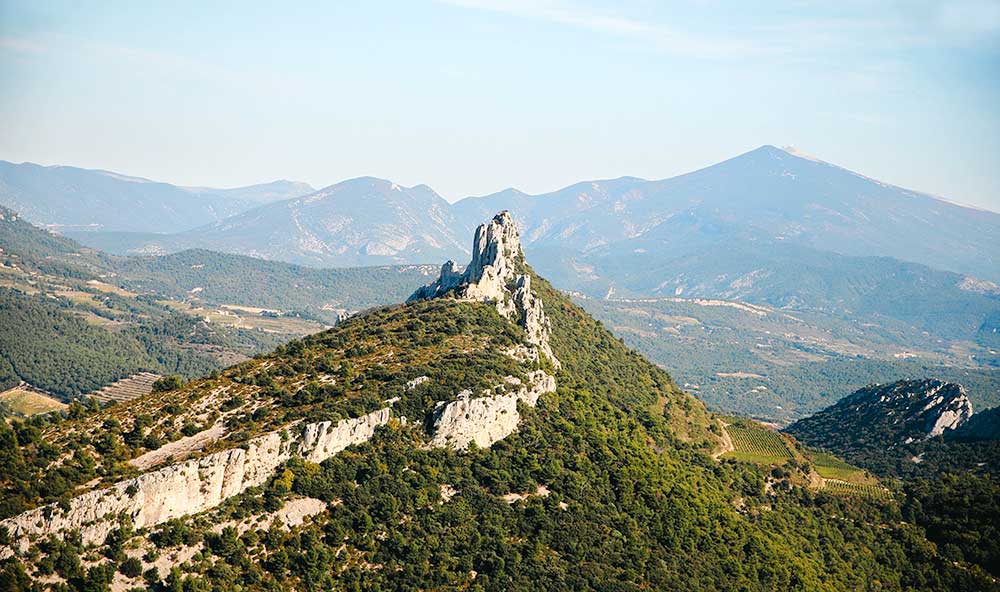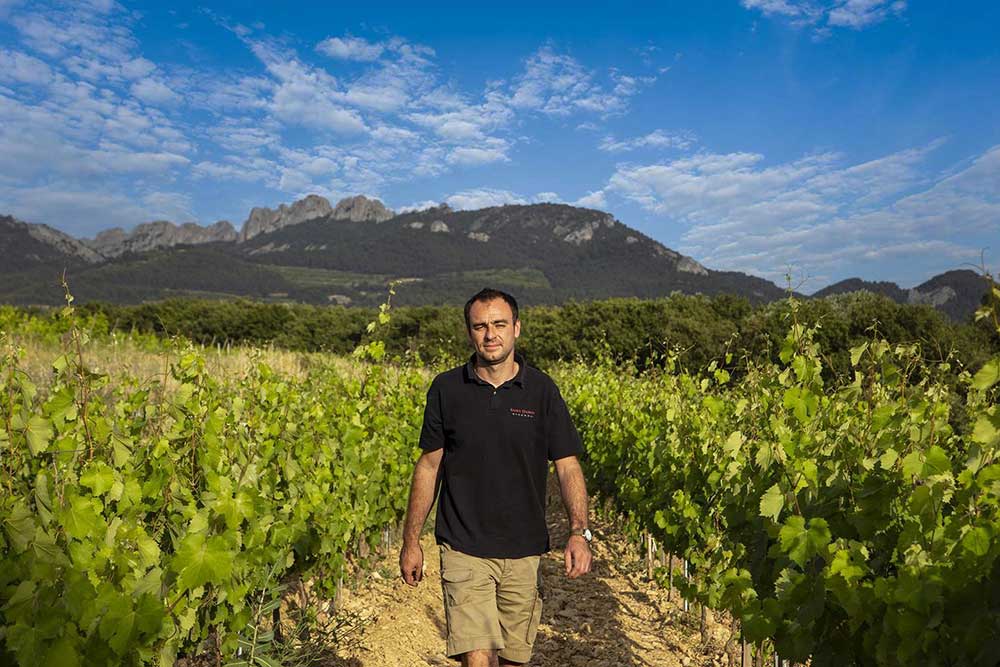The magnificent Rhône region of France follows the Rhône River from Vienne in the north, to Avignon in the south. Separated by about 60km, the region is divided into two sub-regions, the Northern Rhône and the Southern Rhône, both producing vastly different styles of wine. Jancis Robinson MW describes the wines of the Southern Rhône as “France’s most user-friendly,” being approachable, easy to enjoy and relatively affordable.
 The Southern Rhône is wider, flatter, warmer and much larger than the Northern Rhône. The climate in the south is Mediterranean (as opposed to maritime or continental) which means you find more moderate temperature variations between seasons. While the south enjoys more sunshine and less rain, it’s still frequently battered by the Mistral, a strong wind from the north west. The vegetation also changes dramatically, with olive trees, lavender, garrigue (scrubland) and rocky outcrops common in and around vineyards in the south.
The Southern Rhône is wider, flatter, warmer and much larger than the Northern Rhône. The climate in the south is Mediterranean (as opposed to maritime or continental) which means you find more moderate temperature variations between seasons. While the south enjoys more sunshine and less rain, it’s still frequently battered by the Mistral, a strong wind from the north west. The vegetation also changes dramatically, with olive trees, lavender, garrigue (scrubland) and rocky outcrops common in and around vineyards in the south.
The best-known of the 9 Crus of the Southern Rhône is of course Châteauneuf-du-Pape (CNDP), but worldwide demand for its gloriously rich and generous wines has pushed prices beyond the reach of most. It’s also focused attention on the more affordable wines of nearby Gigondas, an appellation traditionally in the shadow of CNDP, but more recently appreciated by astute drinkers for the value it offers.
.jpg) Gigondas
Gigondas
As a respected colleague said to me “We need to bang the drum for Gigondas a lot louder - crazy good wines at half the price (or less) of Châteauneuf-du-Pape.”
The countryside around the tiny village of Gigondas has been noted for its wine since Roman times, but when official appellation rules were introduced in France in the 1930s, the area was rather surprisingly relegated to the generic Côtes du Rhône status. It took until 1966 for it to be elevated to ‘Côtes du Rhône-Villages’ and in 1971 it was finally recognised with its own appellation.
The appellation sits within the Vaucluse département, a mere 10 miles northeast of Châteauneuf-du-Pape (CNDP), and with approximately 1,200ha of vines, is only about a third of the size. The often-terraced vineyards are protected by the imposing Dentelles de Montmirail, a saw-toothed limestone mountain range. Another feature of the landscape is the prevalence of garrigue, a low, soft and fragrant shrubbery found in limestone soils across parts of southern France.
With no white and about 1% rosé, it’s safe to think of Gigondas as a red wine appellation.
The official website for the Rhône Valley notes (with typical French bureaucratic simplicity) the makeup of Gigondas as:
So Gigondas is essentially a grenache dominant blend with a bit of syrah (shiraz) and mourvèdre, a blend we’re familiar with here in Australia.
.gif) Traditional Gigondas is made in a similar way to CNDP, with long maceration. This means that when the wine is being made, it spends a long time in contact with the grape skins, giving it plenty of oomph and colour. Gigondas tends to be full, earthy, aromatic and relatively high in alcohol.
Traditional Gigondas is made in a similar way to CNDP, with long maceration. This means that when the wine is being made, it spends a long time in contact with the grape skins, giving it plenty of oomph and colour. Gigondas tends to be full, earthy, aromatic and relatively high in alcohol.
The most commonly associated descriptors are powerful and rustic. You’ll find they have a lot in common with grenache from around the word, but likely have mineral notes and the telltale savoury herbal perfumed characteristics of garrigue, which “seems to encompass thyme, rosemary, sage, lavender, garlic and chives, often a signature component of southern French red wines.” Eric Asimov, NY Times wine critic.
“(Gigondas)… are often thick-textured, with rugged tannins that give them their rustic reputation. But the best examples marry ripe, dark black fruit with fine-grained tannins and perfumed, minerally finishes. These wines age well, delivering mesquite, iron and black tea notes after five to eight years.” James Molesworth, Wine Spectator.
“A glass of Gigondas should provide a stimulating mix of plum or prune fruit, dark berries, spice, pepper and dried herbs. These are genuine, fresh, often well-priced wines, and finesse rather than raw strength quite rightly features in the appraisal of a Gigondas, be it young or mature.” John Livingstone-Learmonth, Decanter Magazine, Jan 2016.
Similar to the CNDP tradition, Gigondas producers also use a heavy bottle embossed with a distinctive insignia. This one features the hunting horn of the family of Orange (who ruled this area from the 12th century), and olive branches.
Domaine Saint Damien
I’ve offered wine from this Gigondas based estate several times in the past and am excited to offer you their latest releases from the 2022 vintage.
 Romain Saurel in Domaine St Damien's organic vineyards.
Romain Saurel in Domaine St Damien's organic vineyards.
The seriously underrated Domaine St Damien has been run by the Saurel family since 1821, with the current custodians Joel and Amie Saurel at the helm since 1978. The couple changed the name to St Damien in 1979, naming it after a Chapel, long since fallen down, that stood near the estate, honouring St Damien, an early Christian saint who was martyred in 287AD. In case you were wondering, Damien is the patron saint of doctors, surgeons, blind people and barbers.
The estate traditionally sold its fruit to négociants, however Joel and Amie started to make their own wine in the mid-90s, soon after engaging renowned consultant Philippe Cambie, with admirable results. “Proprietor Joel Saurel, backed up by the inimitable Philippe Cambie as his consultant, has transformed this estate into one of the greatest locations in Gigondas, rivalling the two top producers…” Robert Parker, The Wine Advocate.
Joel is largely responsible for the domaine’s current (insider) fame and was also the one who got the vineyards up to Agriculture Biologique certification in 2012, which means they’re certified organic.
These days the estate has a total of around 45 ha of vines, most of which are quite old and cropped low. Joel and Amie’s son Romain is in charge of winemaking and tends to age the wines in large, traditional concrete vats and old foudres, and then bottles them on the young side to preserve freshness. He also bottles without fining or filtration.
“Domaine Saint-Damien has been producing some of the region’s most elegant wines for years, but for some reason they rarely get the attention they deserve. Pricing here is also admirably fair, which makes this an address to remember for savvy Rhône wine lovers. These wines are now consistently delivering some of the southern Rhône’s greatest values in high-end wine.” Vinous Media, February 2020.
 Domaine Saint Damien Gigondas Vieilles Vignes 2022
Domaine Saint Damien Gigondas Vieilles Vignes 2022
This wine is a blend of 80% grenache and 20% mourvèdre. It was made using traditional methods, with fermentation carried out in lined concrete tanks, followed by extended maceration (5 weeks) and a further 12 months maturation in large oak (foudre). The idea behind this technique is that the concrete tanks allow retention of the natural fruit and mineral elements, while the large old oak allows the benefits of wood maturation without imparting an oaky character. The finished wine is 15% alcohol and sealed with cork.
“Possibly my favorite of the trio,* the 2022 Gigondas Vieilles Vignes (80% Grenache and 20% Syrah) offers a full-bodied, incredibly textured, yet seamless and elegant profile to go with lots of meaty dark fruits, some classic Southern Rhône licorice, roasted herb, and spice box nuances, ripe tannins, and a great finish. It’s another sensational effort from this estate, which continues to go from strength to strength.” (94-96) points, Jeb Dunnuck, October 2023.
*The other two he is referring to are the estate’s more expensive single vineyard wines, La Louisiane and Les Souteyrades. So it’s this, the entry level wine he prefers.
This is simply a great review, and a great price, for an entry level Gigondas.
I can offer it for $59.50 a bottle.
 Choose your summer sparkling HERE
Choose your summer sparkling HERE